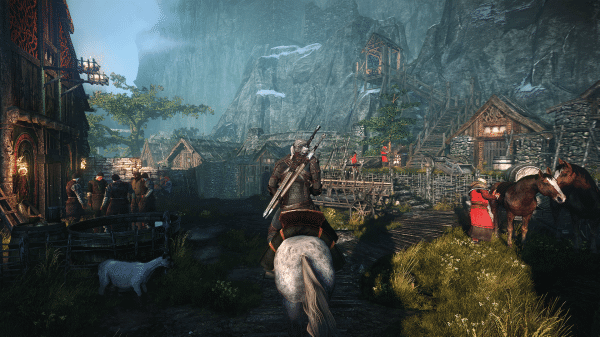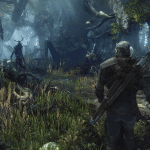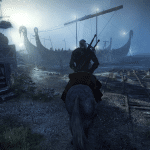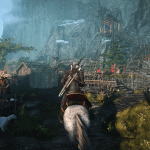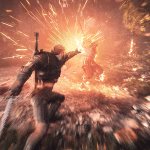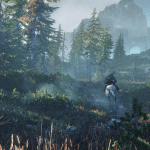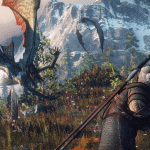The Witcher 3 has been the talk of E3 2013 and rightfully so. After my time watching a demo of the game, the last chapter in the highly acclaimed series is now one of my most anticipated titles for the next generation consoles, and I dare say that The Witcher 3 truly has the potential to be one of the best RPG’s ever made.
For those who are not familiar with The Witcher games, the franchise is loosely based on the books of Polish writer Andrzej Sapkowski and centers around the protagonist Geralt of Rivia, a man who was mutated and trained at an early age to become an extremely powerful monster hunter. While the Witcher 3 does continue the story of the previous games, those who once tried to control Geralt are now gone and he embarks on a more personal journey, allowing newcomers to the series to jump into the Witcher 3 and fully enjoy the experience without any previous knowledge of what happened before. A new dark force by the name of the Wild Hunt has emerged. They are a ghostly group of huntsmen inspired by European folklore and thought to be legend, but they are proven true and they cause misery and chaos wherever they appear.
An open world RPG, the map in the Witcher 3 is huge, considerably larger than any RPG to date. To put it in perspective, the area that was shown in the demo was a series of islands called the Skellige. This area alone is larger than the entire world of Witcher 2. The entire game map is a whopping 35 times larger than the previous game and will take a player 40 minutes to get from end to end on virtual horseback. But thankfully, a new fast travel system has been implemented, and Geralt can travel by horseback, or by boat, once an area has been discovered. There are a number of points of interest throughout the land, encouraging players to discover new areas and go the off beaten path. Thankfully, the games engine allows huge areas to be rendered, which means there will be no loading times.
While the world is very open, it seems CD Projekt Red has taken great care to ensure that the wonderful narrative they are known for does not suffer. The Witcher 3 is a very emergent non-linear story, with true consequences, often putting players in situations where there is no clear good. Your actions will determine the outcome of your story, which may not be evident until hours later, and resonates throughout the world. A random mix of the story, side quests and random encounters are integrated together; there is over 100 hours of gameplay and an astonishing 36 possible endings. I should note that there is an improvement the dialogue system, so the characters can better express a wide range of emotions. We were told that each character has 40 bones in their face to subtly express their feelings.
Weather and the environment play a great role in the behaviour of NPC’s and enemies in The Witcher 3 and the changes will drastically affect the gameplay. A raiding party will venture off to do their job if the sun is out, but if raining they will stay back in the village to drink instead. Werewolves can be easily taken down during the day, but will be extremely difficult to defeat during a full moon. During the game there is a realistic day and night cycle too, adding to the realism.
As a monster hunter, Geralt has special senses that allow him to track down over 80 different monsters throughout the game. In the demo we watched as he moved about the forest, noting footprints, downed trees, and claw marks to determine the beast that was terrorizing a local village. Once known, he must refer to the bestiary essential for survival and killing the monster he is chasing. For example, in the demo it was determined that beast was a Lechen, a horrific, horned, wood spirit. By looking in the bestiary, it was discovered that the creature bonds itself to a human and that human must be eliminated in order to defeat him. Interestingly, there are no bosses found within the game as each battle with these monsters should be considered epic and difficult, and they do not scale to the player’s level.
A new combat system has been implemented with the traditional elements of an RPG and the speed and precision of a fighting game and when combined you’ll find you use a mix of magic (also known as sciences) potions and swordplay. Fans of the series will be quite pleased that quick time events no longer have a place as they have been completely eliminated. The camera system has also been improved. Gameplay is very tactical, very precise, and with an improved alchemy system, potions can be used with ease as a skill.
Although it’s still in early alpha stages it’s quite evident how beautiful this game already is and how incredible it will be when done. The spectacular environments from alpine mountains to quaint villages, everything looks amazingly realistic. This is truly what a next generation game should look like, visually stunning and absolutely breathtaking. After the 45-minute demo I was left in awe. With an enormous open world, an interesting narrative, robust RPG elements, tactical gameplay, and gorgeous next-gen graphics I can’t wait to fully immerse myself in the finished game when it releases sometime in 2014.
